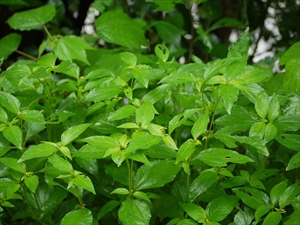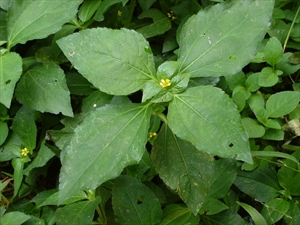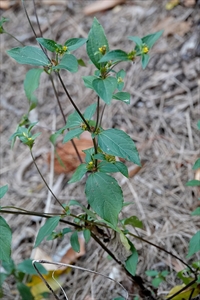Cinderella weed. It is also known as synedrella.
Pacific Pests, Pathogens and Weeds - Online edition
Pacific Pests, Pathogens & Weeds
Cinderella weed (490)
Synedrella nodiflora; previously, it was known as Verbesina nodiflora. It is a member of the Asteraceae.
Asia, Africa, North (Florida, Hawaii), South and Central America, the Caribbean, Oceania. It is recorded from Australia, Fiji, French Polynesia, Guam, New Caledonia, Papua New Guinea, Samoa, Solomon Islands, and Tuvalu. It is native to tropical America.
An invasive weed of gardens, parks, roadsides, wastelands in the tropics and subtropics (Photo 1). It germinates rapidly, has a short life cycle (as little as 100 days), produces large numbers of seed (thousands per m2). Also, grows in a wide range of soils (although it favours those of high organic matter). It favours light shade, although it will also grow in full sunlight, and is found up to 1200 masl.
A small herbaceous, annual plant, with erect stems, 30-80 cm tall, hairy, woody, quadrangular, with long internodes, sometimes rooting from nodes at the base. Leaves opposite along the stem, with pointed tips, on short stalks, 4-9 cm, oval, and finely serrated margins. Flowerheads, in groups of two to eight from axils of the leaves, and tips of the stems on the upper third of the plant (Photos 2&3). Each flowerhead is 5-10 mm across, with 10-20 yellow flowers, composed of outer ray and inner disc florets, 3-4 mm long, and surrounded by small, modified leaves (bracts). The seeds with two to four bristles at one end, called awns.
Spread is by seed in water, wind, on plant debris and on clothing attached by bristles. Long distance spread occurs in contaminated seed lots. Note, the outer, ray flowers produce seed that is dispersed first and germinates quickly; the inner, disc flowers, produce seed that is dormant for several months.
Its impact is greatest in low-growing crops, such as vegetables, where dense stands compete for light, and increased humidity encourages infection of plant pathogens. CABI notes that it is host to Cylindrocladium quinqueseptatum, a leaf spot and shoot blight of Eucalyptus seedlings, Coynespora cassicola, which causes a serious leaf spot disease of tomato (see Fact Sheet no. 163), and cucurbits (see Fact Sheet no. 189), as well as host to root knot nematodes (see Fact Sheet no. 127).
When cooked it is eaten as a vegetable and, e.g., in Papua New Guinea, fed to pigs. The leaves are used medicinally as a treatment for rheumatism and a laxative.
BIOSECURITY
Countries not yet infested by cinderella weed should consider all likely pathways for entry, and apply quarantine measures accordingly. Particular attention should be given to its spread by seed which is produced in large numbers and the fact that each has bristles which easily attach to clothes and, possibly, to machinery.
BIOLOGICAL CONTROL
Not a method recommended for cinderella weed.
CULTURAL CONTROL
- Physical & Mechanical:
- Pull-out plants by hand, preferably before flowering and production of seed.
- Hygiene:
- Treat vehicles and farm machinery. If moving from areas where the weed occurs to those weed-free, wash to remove soil. This is equally important if the machinery is being imported into a country or moved within a country.
CHEMICAL CONTROL
In Australia, only MCPA + terbutryn is registered for use on cinderella weed.
____________________
When using a pesticide, always wear protective clothing and follow the instructions on the product label, such as dosage, timing of application, and pre-harvest interval. Recommendations will vary with the crop and system of cultivation. Expert advice on the most appropriate herbicides to use should always be sought from local agricultural authorities.
AUTHOR Grahame Jackson
Information from CABI (2019) Synedrella nodiflora (synedrella). Invasive Species Compendium. (https://www.cabi.org/isc/datasheet/52325); and from Le Bourgeois T, Pascal M (2020) Synedrella nodiflora (L.) Gaertn. WIKTROP. (https://portal.wiktrop.org/species/show/320). Photo 1 Dinesh Valke Ngaroiarui (in Maori) Asteraceae (aster, daisy, or sunflower family) Synedrella nodiflora. family). Photo 2 Tau'olunga Synedrella nodiflora (pakaka in Tonga), a weed, almost lookalike but different from Eleutheranthera ruderalis.
Produced with support from the Australian Centre for International Agricultural Research under project HORT/2016/185: Responding to emerging pest and disease threats to horticulture in the Pacific islands, implemented by the University of Queensland and the Secretariat of the Pacific Community.






